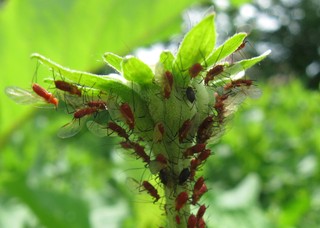How to effectively treat and avoid indoor garden pests

Many people are drawn to indoor gardening because of the numerous advantages it has over traditional gardening done outdoors, including reduced problems with pests. This doesn’t mean however pest problems never occur but rather they occur less often and are typically easier to treat.
When pest problems do occur indoors they’re typically the same insects that afflict outdoor plants; due to indoor conditions though treatment and prevention methods are slightly different. Here are our top recommendations for controlling and eliminating these bugs from any indoor herb garden.
Most common indoor garden pests
The most commonly found pests on indoor plants are aphids, thrips, mealybugs, spider mites, scale, whitefly, and fungus gnats. Many other insects can find their way into your home and infest your plants but these seven are the ones you’ll typically see.
-
Aphids are one of the most common plant pests affecting both indoor and outdoor plants. The minuscule pear-shaped insects attach themselves to the plant, sucking sap through two tubes projecting rearward from their abdomen causing distorted foliage and leaf drop. Aphids produce and secrete honeydew which increases the susceptibility of sooty mold growth; honeydew is a high sugar source of nutrition utilized by sooty mold fungi.[1]
-
Thrips are tiny, slender insects with fringed wings that feed on the sap of garden plants. Damaged plant leaves may appear blotchy, turn pale, progressing to a silvery color, and then die. Worse than the damaged tissue is the plant viruses often spread when thrips feed.
-
Mealybugs are pink, soft-bodied insects covered with a white, waxy, almost cottony-like material; this fluff protects them from moisture loss and excess heat. They typically form colonies in protected areas of the plants such as on the bottom of leaves or the crook of branches. Symptoms include stunted or deformed leaf growth as mealybugs inject a toxin into leaves when they feed on the plant’s fluid and honeydew accumulations.
-
Spider mites are tiny sucking pests found on the undersides of leaves. They feed on the fluids found inside the leaves, piercing the waxy coating to access the internal fluids. Spider mites are challenging because they are prolific; often times a heavy infestation will occur, unnoticed, before plants begin to show physical symptoms of damage. A plant with spider mites may exhibit leaves stippled with discoloration or overall yellowing, and perhaps a spider-like webbing between the leaves of the plant.
-
Scale occurs as two different types: soft and armored scale. Both types of scale appear as little brown bumps on leaves with the soft scale more prevalent. Insect sizes range from ⅛ to ½ inch in length; color, shape, and texture vary amongst different species. Leaves wilt and prematurely drop when infected with scale; branches/stems experience dieback if left untreated.
-
Whitefly is closely related to scale and aphids and is often mistaken for tiny white moths or even mealybugs. Insects are usually pale in color, almost translucent, and are covered with a powdery whitish wax. When the host plant is disturbed they quickly take to flight making them hard to treat. Both nymphs and adults are sap-suckers and exude honeydew. Infestation symptoms include stunting, yellowing of leaves, and leaf drop.
-
Fungus gnats aren’t much of a problem to plants, but they are a nuisance to people in the home. Similar in looks to fruit flies, these small dark flies are inefficient fliers so they stick close to the soil, especially if it’s damp. Heavy infestations may result in insects feeding upon root hairs or moving pathogens into the soil.

Citrus thrips like this one are just one of many pests that can cause problems for indoor herb gardens. Image: Katja

The enthusiast's guide to herbs
We’re proud to present our new e-book, The Enthusiast’s Guide to Herbs! Learn everything you need to know about growing and caring for herbs indoors, including in-depth info cards for the 35 most commonly grown herbs.
Click the link below to find out more!
Treating indoor pests
It’s slightly more tricky when you find yourself needing to manage a pest problem on indoor plants. For a large number of gardeners, they quickly turn towards chemical applications or natural predators to eradicate bugs on outside plants. Most people don’t want to be spraying insecticides inside their homes though or tossing out their beloved houseplants so they look towards a more natural approach.
Manually removing insects
The safest, most non-toxic treatment method for indoor garden pests is to take the time to manually remove them yourself from the plants. This works best when the infestation is small or your plants have larger or fewer leaves.
Removing them by hand may be time-consuming but it’s effective. Use a pair of clean tweezers to remove insects individually or wipe plant leaves gently with a clean, damp cloth (if the plants do not have fuzzy/hairy leaves) to remove the bulk of the pests. Then take your tweezers and get into the nooks and crevices where leaves attach to stems or branches.
For plants with numerous leaves or a heavy infestation, it may be more effective to rinse the entire plant with tepid water from the kitchen sink sprayer or a showerhead. Use caution to not damage the plant with a forceful stream of water! You can also flip the container upside down – making sure to keep hold of the potting soil – and dunk the entire foliage in a tepid water bath, swishing it around to knock the insects loose.
Natural treatment options
If manually removing insects doesn’t sound like a fun thing to do, or the infestation is more severe than you expected, there are a couple of natural treatment options you can use.
Spraying with a soap solution is a safe, non-toxic method for treating problems. Using a clean spray bottle, mix one tablespoon of “pure” liquid soap per quart of bottled or distilled water. Steer clear of dish soaps claiming to cut grease as they can damage the waxing coating on plant foliage. The fatty acids in the pure insecticidal soaps suffocate small, soft-bodied insects and disrupt permeability and structure of their cellular membranes.
For insects such as scale and mealybugs, you can spot treat your plant with rubbing alcohol. Before starting testing on an inconspicuous area to make sure it won’t damage the leaves. Dip a cotton swab in rubbing alcohol and then use it to saturate the insects one at a time.
Chemical treatment options
Neem oil is a naturally occurring pesticide that is made from the pressed seeds of the neem tree; it is considered one of the least toxic botanical pesticides to humans and shows very low toxicity to beneficial organisms.[2] You can purchase it on Amazon.
The active ingredient is azadirachtin, a substance that blocks the production and release of hormones that transition insects from larva to pupa to adult. In turn, molting cannot occur and the life cycle ceases; it is especially effective in treating mealybugs, aphids, whiteflies, thrips, and fungus gnats.
Prevention methods
Being mindful in preventing pest problems in your indoor garden plants helps to reduce the number of problems you may have to treat. These following methods are the best ways to prevent pest problems.
-
Inspect all new plants coming into the house. Without a doubt, this is the best way to prevent insect infestations in your indoor garden. Any time you purchase a new plant or are gifted one from a friend or neighbor, thoroughly inspect it visually before adding it to your collection. If it has any insects treat it before placing it with healthy plants.
-
Maintain good air circulation between plants. Give plants some space between themselves and their neighbors, and provide them with some gentle, moving air from a fan if possible. This breeze helps to prevent damp conditions that encourage insects and also makes it harder for flying pests to land on foliage.
-
Don’t over fertilize. Providing proper nutrition to your plants is important, but over fertilizing plants weakens them, causing stress. When plants are stressed they are more susceptible to insect attacks, mainly sap-feeding pests.
-
Quarantine infested plants. Once a pest infestation is noted it’s critical to remove the infected plant and place it in a quarantined location during treatment. Simply putting distance between it and your healthy, uninfected plants will help reduce the chance the infestation spreads.
-
Clean gardening equipment after each use. Regardless of if you are working with healthy plants, or those infected with bugs, after completing your work make sure to clean and sterilize all equipment you used. This will stop the unintentional transfer of insects from one plant to another.
-
**Choose indoor garden plants less prone to pest problems such as:**
- Carnivorous plants
- Snake plant
- Jade
- Bromeliad
- Aglaonema
- Citronella
- Pungent herbs
Conclusion
Growing plants indoors provides many benefits to traditional gardening, one benefit being a reduction in pest problems, but they do still occur. It’s important to be aware of the aforementioned common pests, how to treat them, how to prevent them, and even which plants are less prone to pest problems. This knowledge helps to avoid and control insect garden pests much more effectively.

Join our email club—get printable info cards free!
Sign up to receive our newsletter and get access to 10 printable plant info cards from our e-book for free. Also receive:
- $4 discount code for our Guide to Herbs e-book
- Semi-weekly plant inspiration & bite-size tips and tricks
Dhami, M. K., Weir, B. S., Taylor, M. W., & Beggs, J. R. (2013). Diverse honeydew-consuming fungal communities associated with scale insects. PloS one, 8(7), e70316. doi:https://doi.org/10.1371/journal.pone.0070316{: target=“_blank” rel=“noopener”} ↩︎
Campos, E. V., de Oliveira, J. L., Pascoli, M., de Lima, R., & Fraceto, L. F. (2016). Neem Oil and Crop Protection: From Now to the Future. Frontiers in plant science, 7, 1494. doi:https://doi.org/10.3389/fpls.2016.01494{: target=“_blank” rel=“noopener”} ↩︎

